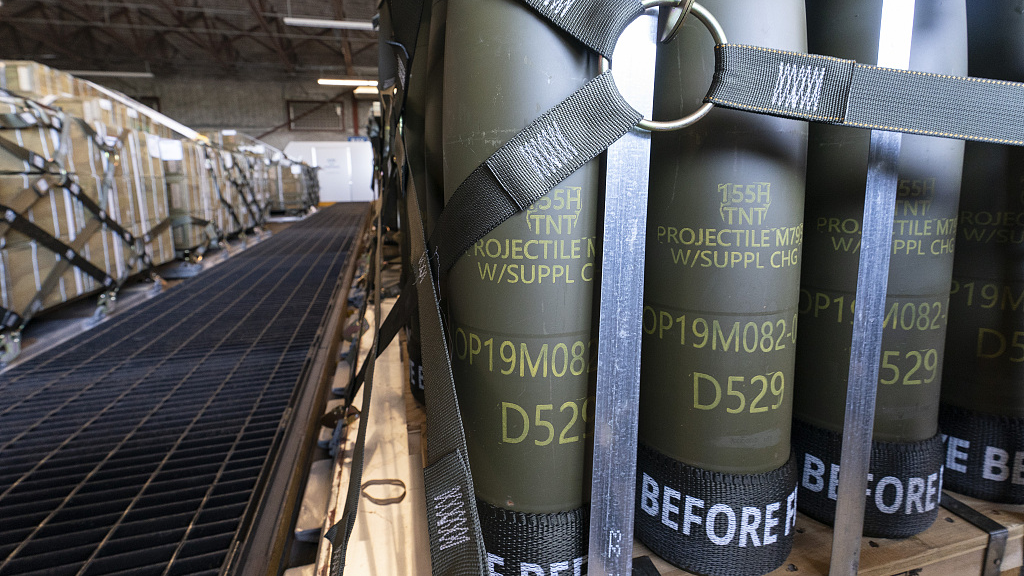
Pallets of 155 mm shells ultimately bound for Ukraine are loaded by the 436th Aerial Port Squadron, at Dover Air Force Base, Del, the United States, April 29, 2022. /CFP
Pallets of 155 mm shells ultimately bound for Ukraine are loaded by the 436th Aerial Port Squadron, at Dover Air Force Base, Del, the United States, April 29, 2022. /CFP
Editor's note: Hayat Bangash is a freelance columnist on international affairs with degrees in business administration and war studies. The article reflects the author's opinions and not necessarily the views of CGTN.
The largest-yet weapons shipment for Ukraine, promised by the U.S. earlier this month, could be well on its way right now. Staff at multibillion-dollar weapons manufacturing companies could be packing and dispatching heaps of advanced weapons like High Mobility Artillery Rocket Systems (HIMARS), howitzer shells, and anti-defense missiles.
The $1 billion worth of weaponry being supplied is far from the regular off-the-shelf equipment warring parties procure to keep fighting. It is truly advanced stuff, the supply of which is far more detrimental for Ukraine than it is for Russia.
The foremost reason for the detriment is the long range of HIMARS. Capable of hitting targets 80 kilometers away, they can target Russian posts from well behind Ukrainian lines. While U.S. President Joe Biden has so far been trying to avoid direct provocation of his Russian counterpart, this single weapon has the potential to test the latter's restraint.
Ukraine has assured it will not use HIMARS on Russian territory, according to the U.S. Secretary of State Antony Blinken. But promises seldom survive in the heat of battle.
As each new piece of American hardware lands in Ukraine, the risk of escalation gradually increases. These supplies might not immediately provoke Russia, since the intention is to remain below that threshold, but they are micro-steps up the escalation ladder. Any single miscalculation and the situation can spiral out of anybody's control.
These high-tech weapons are not cheap either. Voices like Senator Rand Paul's are telling Americans not to save Ukraine by dooming the U.S. economy. With no special inspector general to scrutinize, the aid to Ukraine, according to the senator, is larger than many domestic programs.
Missing too, is the scrutiny of the distribution of the weapons. The ranks of Ukrainian forces include elements with troubling histories. To name one, the Azov Battalion is an ultranationalist, racist and extremist militia with Neo-Nazi ideologies, now part of the National Guard. Arming them without accountability could bear the same results that were seen after arming "friendly extremists" in Syria.
Taking place in what has been a hub of arms trafficking with a thriving black market since the fall of the Soviet Union, the distribution can lead to criminal networks bidding for American weapons. The Secretary General of Interpol and the Executive Director of Europol have already expressed these concerns.
The human cost will be borne by developing countries where these weapons will ultimately end up. We might be looking at an impending resurgence of violent extremism, rearmed with state-of-the-art weaponry.
Whispers of the U.S. retreat from Afghanistan echo frequently in Ukraine. On one day Washington was brimming with support for the Ashraf Ghani government, while on the next, American scaffolding was flying back in C-17s, leaving behind a falling Kabul.

A child receiving treatment for malnutrition is cared for on a children's ward at Indira Gandhi hospital in Kabul, Afghanistan, August 13, 2022. /CFP
A child receiving treatment for malnutrition is cared for on a children's ward at Indira Gandhi hospital in Kabul, Afghanistan, August 13, 2022. /CFP
If pulling the rug from under the feet of the Afghan government was not easy, pulling the plug of military aid in Ukraine is. As Biden's age-induced decision-making comes under question and Donald Trump's campaign trail draws thousands, the latter's return to the White House with a commitment to withdraw from forever wars remains a remote but imaginable possibility.
Even by today's assessments, most people believe that Ukraine is not capable of defeating the Russian military might. Cognizant of this fact, the U.S. cannot make Ukrainians outrightly tip the balance. The aim, simply, is to bleed the Russian economy and disallow it to support the war. But bleeding along with it are the Ukrainian people and the American exchequer.
Afghanistan remained an open wound on the American budget for 20 years. It remains to be seen, however, how long American taxpayers will be willing to fuel another conflict.
The U.S. has seen the Afghan military melting before American boots could leave the ground, the Iraqi Army nearly collapsing on the emergence of ISIL, and South Vietnam falling just two years after the American withdrawal.
Clearly, it has not been the recipients of American military aid that have benefited. Who have benefited, actually, are the American Congress members or their spouses who hold stocks in conglomerates supplying weapons to conflict zones.
The solution is not in paying heed to American Congress members who profit from wars; the solution is in bringing about a negotiated settlement of the conflict. Moscow and Kyiv have concerns that must be heard and addressed. That can happen at the negotiation table, not in boardrooms of the American military-industrial complex.
(If you want to contribute and have specific expertise, please contact us at opinions@cgtn.com. Follow @thouse_opinions on Twitter to discover the latest commentaries in the CGTN Opinion Section.)

